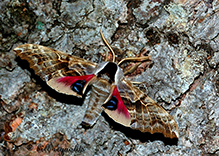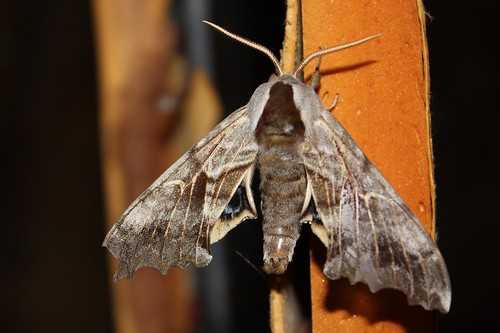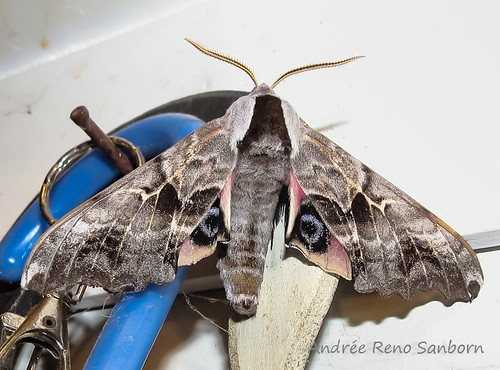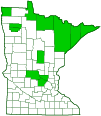one-eyed sphinx
(Smerinthus cerisyi)
Conservation • Description • Habitat • Ecology • Distribution • Taxonomy
|
|
||||||||||||||||||
Description |
One-eyed sphinx is a large, nocturnal sphinx moth. It has a wingspan of 2 7 ⁄16″ to 3 9 ⁄16″. The outer margin of the forewing may be irregularly scalloped or almost smooth and has a blunt “tooth” at the anal angle. The upper side may be gray or tan with irregular banding. There is a broad blackish median band and a broad dark terminal band. The upper side of the hindwing is bright rosy pink near the base fading abruptly to tan near the margin. There is a large black eyespot near the inner margin with an incomplete bright blue circle in the center. There is sometimes a blue crescent at the top of the black eyespot. The thorax has a black dorsal patch. The appendage (tegula) covering the forewing base is pale gray. The abdomen is gray with a dark dorsal stripe. The caterpillar is up to 2⅜″ long and variable in color. It may be green, bluish-green, or yellowish-green. The head, thorax, and abdomen are moderately covered with prominent, minute, white bumps. The head is broadly triangular, flattened, and framed with a wide pale cream or yellow stripe. A long curved horn extends from the eighth abdominal segment. It may be yellow, pink, and/or blue. There is a pale cream to yellow subdorsal stripe that extends from the first thoracic segment to the seventh abdominal segment; and a bold whitish diagonal line that extends from the horn to just above the leg-like structure (proleg) on the sixth abdominal segment. Abdominal segments 1 through 6 each have a lateral, yellowish, diagonal line and a faint red circle surrounding the white respiratory opening (spiracle). Mature caterpillars can be found from July through September. |
Size |
Wingspan: 2 7 ⁄16″ to 3 9 ⁄16″ |
Similar Species |
Habitat |
Valleys, streamsides |
Ecology |
Season |
One brood: mid-May to early July |
Behavior |
When perched, the wings are held elevated, slightly away from the body, and parallel to the resting surface. Males arch their abdomen upwards when at rest. Females do not. Adults fly at night and are attracted to light. |
Life Cycle |
Females attract males by releasing pheromones. After mating, she lays spherical green eggs singly or in pairs on the underside of host plant leaves. The eggs hatch in 6 to 8 days and the caterpillars begin feeding on leaves and fruit of the host plant. |
Larva Hosts |
Mostly poplar (Populus) and willow (Salix). |
Adult Food |
Adults do not feed. |
Distribution |
||
|
Sources 21, 24, 27, 29, 30, 71, 75, 82, 83. Biodiversity occurrence data published by: Minnesota Biodiversity Atlas (accessed through the Minnesota Biodiversity Atlas Portal, bellatlas.umn.edu, 8/14/2025). |
|
| 8/14/2025 | ||
Occurrence |
||
Common |
||
Taxonomy |
|
Order |
|
Superfamily |
Bombycoidea (Hawk, Sphinx, Silk, Emperor, and Allied Moths) |
Family |
|
Subfamily |
Sphinginae (eyed sphinx moths) |
Tribe |
Smerinthini |
Genus |
Smerinthus (eyed hawkmoths) |
Subordinate Taxa |
|
|
|
Synonyms |
|
Smerinthus astarte Smerinthus borealis Smerinthus cerysii Smerinthus geninatus Smerinthus nigrescens Smerinthus ophthalmica Smerinthus opthalmica Smerinthus pallidulus Smerinthus vancouverensis |
|
Common Names |
|
Cerisy’s sphinx moth one-eyed sphinx willow sphinx |
|
Glossary
Anal angle
In insects: The angle at the corner of a wing formed where the outer and inner margins meet.
Proleg
A fleshy structure on the abdomen of some insect larvae that functions as a leg, but lacks the five segments of a true insect leg.
Spiracle
A small opening on the surface of an insect or arachnid through which it breathes.
Tegula
A small, hardened plate or flap-like structure that overlaps the base of the forewing of insects in the orders Lepidoptera, Hymenoptera, Diptera, and Homoptera.
Visitor Photos |
||
Share your photo of this insect. |
||
This button not working for you? |
||
Bill Reynolds |
 |
MinnesotaSeasons.com Photos |
||
|
||
|

Slideshows |
One-eyed Sphinx Moth |

|
About
Smerinthus cerisyi larva: bugguide.net/node/view/37402/bgimage |
One-eyed Sphinx - Hodges#7822 (Smerinthus cerisyi) |

|

Visitor Videos |
||
Share your video of this insect. |
||
This button not working for you? |
||
|
Other Videos |
||
The One-Eyed Sphinx |
About
Uploaded on May 9, 2007 A quick video of Smerinthus cerisyi or the one-eyed sphinx moth.Every year one of these moths shows up on my porch, I usually am not into entomology but this creature is so beautiful and one of the larger insect's here. |
Cerisy's Sphinx Moth |
About
Uploaded on May 4, 2011 Cerisy's Sphinx moth observed near Lumby, BC ( Smerinthus cerisyi ) May 2007 |

Visitor Sightings |
||
Report a sighting of this insect. |
||
This button not working for you? |
||
Karen Girard |
Location: Big Lake (Sherburne County) |
| Bill Reynolds 10/13/2013 |
Location: Pennington Co. |
 |
MinnesotaSeasons.com Sightings |
||
|

Created: 10/13/2013 Last Updated: © MinnesotaSeasons.com. All rights reserved. |
